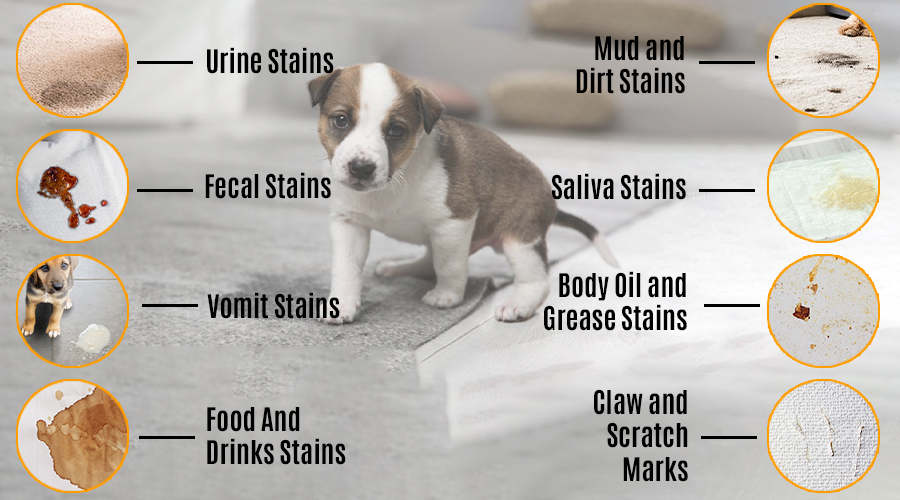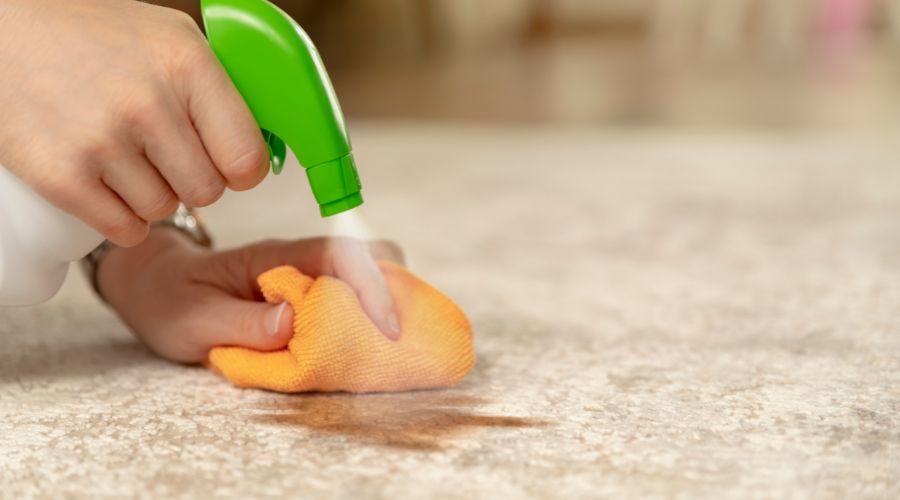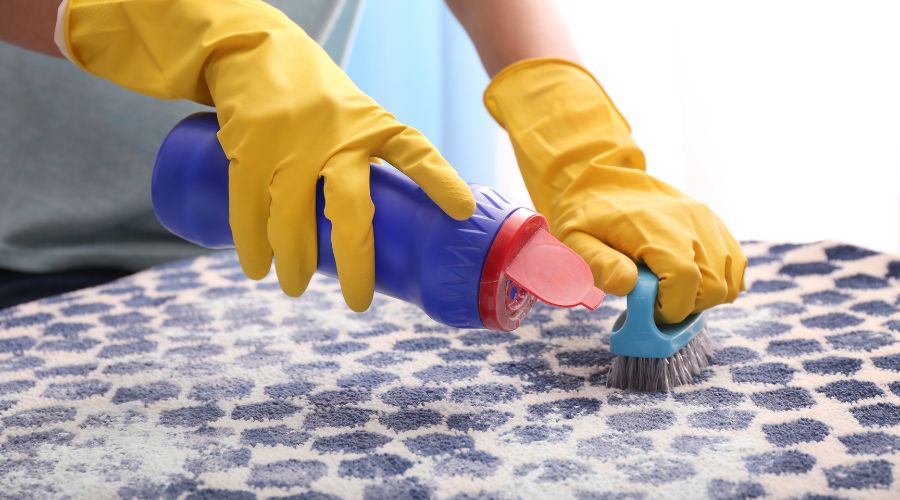Pets bring immeasurable joy, companionship, and unconditional love into our lives. They become cherished members of our families, providing us with endless moments of happiness and warmth. However, alongside all the joy they bring, our furry friends can also leave behind unwanted reminders of their presence in the form of stubborn stains and lingering odors on our beloved carpets. Whether it’s an enthusiastic puppy that hasn’t quite grasped the concept of house training or a senior cat experiencing occasional accidents, dealing with pet stains and odors is a common challenge for pet owners. But fear not, for there is hope! With the right techniques and tools at your disposal, you can successfully eliminate those pesky pet stains and odors, restoring your carpet to its former freshness and cleanliness.
In this blog post, we will delve into a variety of simple yet highly effective cleaning tips that will empower you to tackle even the toughest pet stains and banish those lingering odors from your carpet once and for all. So, let’s embark on this journey together and discover the secrets to maintaining a pristine carpet in the company of our beloved four-legged companions.
1. Types Of Stains Your Carpet Gets From Your Pet

Pets can unintentionally leave various types of stains on your carpet. Here are some common types of stains you may encounter:
- Urine Stains: Pet urine stains can be a common occurrence, particularly with puppies, senior dogs, or pets that are not fully trained. Urine stains can be problematic because they can seep deep into the carpet fibers, leading to discoloration and strong odors. If not addressed promptly, urine stains can also attract bacteria and result in a lingering smell.
- Fecal Stains: Accidents happen, and pets may sometimes defecate on the carpet. Fecal stains can be challenging to remove due to their solid nature and potential for smearing during cleaning. These stains not only leave unsightly marks on the carpet but can also cause unpleasant odors.
- Vomit Stains: Pets may vomit on the carpet due to various reasons, including illness, digestive issues, or consuming something they shouldn’t have. Vomit stains can be particularly bothersome as they often contain stomach acids and can leave behind both visible marks and unpleasant smells.
- Food and Drink Stains: Pets can be messy eaters or drinkers, causing spills and stains on the carpet. Whether it’s knocked-over water bowls or scattered kibble, these stains may contain dyes or residues that can be challenging to remove completely.
- Mud and Dirt Stains: Pets love to explore the outdoors, and when they come back inside, they may bring in dirt, mud, or other outdoor debris on their paws. This can lead to muddy footprints, smudges, or tracked-in dirt on the carpet, resulting in visible stains.
- Saliva Stains: Some pets, such as certain dog breeds or those with excessive drooling, may leave behind saliva stains on the carpet. These wet spots or discolored areas can be particularly noticeable, especially if they accumulate over time.
- Body Oil and Grease Stains: Pets with oily skin or fur, such as some breeds of cats or dogs, can leave behind body oils and greasy residues on the carpet. These stains may appear as dark or discolored patches and can be challenging to remove without the right cleaning methods.
- Claw and Scratch Marks: Pets, particularly cats, may scratch or dig their claws into the carpet, causing visible damage and leaving scratch marks. These marks can be unsightly and may require additional steps to repair or restore the affected carpet fibers.
2. Tips To Remove Pet Stains And Odors From Carpet

Act Quickly: Quick action is crucial in effectively removing pet stains from carpets. The moment a pet stain is discovered, it’s essential to quickly grab a clean cloth or paper towel and blot up as much of the liquid as possible. Avoid rubbing the stain, as it can spread the stain and make it more challenging to remove. Blotting prevents the stain from setting and soaking deeper into the carpet fibers. By acting promptly, you increase your chances of successfully eliminating the stain from your carpet.
Blot, Don’t Rub: When dealing with a fresh pet stain on your carpet, avoid rubbing or scrubbing it vigorously, as this can push the stain deeper into the carpet fibers and spread it to a larger area. Instead, use a blotting technique with a clean cloth, paper towel, or absorbent material. Begin from the outer edges of the stain and work your way toward the center. Be patient and repeat the process until no more liquid is being transferred to the absorbent material. This will minimize the risk of spreading the stain and allow for a more effective and efficient removal process.
Prepare A Homemade Stain Remover: Creating your own stain remover at home presents a cost-effective and environmentally friendly solution to tackle pet stains on your carpet. One popular DIY stain remover recipe involves combining one part white vinegar with two parts warm water. The acidity of vinegar helps neutralize odors and break down stains effectively. Before applying the solution to your entire carpet, it’s crucial to perform a patch test in an inconspicuous area to ensure it doesn’t cause any discoloration or damage to the carpet fibers.
Once you’ve confirmed the solution’s compatibility with your carpet, pour it into a spray bottle for easy application. The spray bottle allows for even distribution of the solution over the affected area, ensuring thorough coverage. With your homemade stain remover ready, you are well-equipped to tackle pet stains with a natural and affordable alternative. Remember, always exercise caution and test any homemade solution before applying it widely to your carpet.
Treat the Stain: Spray a sufficient amount of your homemade stain remover onto the stained area once it is ready. For the solution to reach the stain, let it sit for a while. The stain will become loosened as a result, making removal simpler. The stain should then be gently blotted with a clean cloth or sponge while exerting light pressure to take the spot from the carpet. Work your way towards the center of the stain from the stain’s margins. Repeat this procedure up until the stain is gone.
If the stain persists, consider using a commercial pet stain remover designed specifically for carpets. These products are formulated to tackle tough stains and odors caused by pets. Follow the instructions provided on the product for the best results.
Use an Enzymatic Cleaner: Enzymatic cleaners are specially formulated to break down organic compounds found in pet stains, such as urine, feces, and vomit. These cleaners contain enzymes that target and digest the proteins and bacteria responsible for the stain and odor. To use an enzymatic cleaner, apply it to the stain, let it sit for the recommended time, and then blot or rinse it away as instructed. Multiple applications may be necessary for stubborn stains. By following these steps, you can effectively eliminate pet stains and odors from your carpet.
Use Baking Soda: Baking soda is a versatile household ingredient that can help eliminate pet odors from your carpet. After blotting up the pet stain, sprinkle a generous amount of baking soda over the affected area. Allow the baking soda to sit for a few hours or overnight to absorb and neutralize the odors. Thoroughly vacuum the area to remove the baking soda along with any trapped odors. By using baking soda, you can effectively and naturally combat unpleasant pet odors.
Test the Cleaner: Before using any cleaner on your carpet, it’s important to conduct a compatibility test on a small, inconspicuous area. Apply a small amount of the cleaner to the test spot and wait for a few minutes to observe any potential discoloration, fading, or adverse effects on the carpet fibers. This step helps ensure that the cleaner will not cause any damage or undesirable changes to the appearance or texture of your carpet. Remember to be cautious and test any new cleaner or product before applying it to a larger and more visible area of your carpet.
Steam Clean: Consider steam cleaning your carpet to ensure a deep clean and eliminate any remaining traces of pet stains and odors. Renting a steam cleaner or hiring a professional carpet cleaner can effectively sanitize your carpet and leave it fresh. Focus on areas where your pet spends the most time and follow the instructions provided with the steam cleaner. Steam cleaning not only removes pet stains and odors, but also helps eliminate allergens and bacteria, creating a healthier environment for you and your pets.
Avoid Ammonia-Based Cleaners: Ammonia is not recommended for cleaning pet stains due to its scent resembling urine, which can attract pets back to the same spot. It can also interact with the chemicals in urine, potentially intensifying the odor. Instead, enzymatic cleaners or pet-specific cleaning products should be used. Enzymatic cleaners break down proteins and bacteria in pet stains, effectively removing both the stain and odor. By choosing the right products, you can safely and effectively eliminate pet stains and odors without any negative consequences.
Consider Professional Cleaning: If your efforts to remove pet stains and odors from your carpet prove to be unsuccessful, or if you’re dealing with a large area affected by multiple stains, it may be beneficial to seek professional carpet cleaning services. Professional cleaners have access to specialized equipment, powerful cleaning solutions, and industry knowledge to tackle even the toughest pet stains. They can assess the extent of the damage, provide deep cleaning treatments, and help restore your carpet to its original condition.
Prevention is Key: To prevent pet stains and odors from becoming a problem, it is important to take proactive measures. This can include using pet-friendly rugs or mats in high-traffic areas, training your pets to use designated elimination areas, promptly cleaning up any accidents that do occur, and using pet-specific cleaning products for accidents on hard surfaces. Regular grooming of your pets can also help reduce shedding and minimize the chances of stains on your carpets. By taking these steps, you can create a clean and odor-free home environment for both you and your pets.
3. How To Prevent Your Carpets From Future Pet Stains?

Purchase Stain Resistant Carpet: A proactive step to avoid future pet stains is purchasing carpet that is stain-resistant. Look for carpets that feature stain-resistant technology, such as liquid-repellent coatings or stain-resistant fibers. Think about fibers like nylon or polyester that are recognized for being stain-resistant. Verify any stain-resistance warranties or guarantees. Follow suggested maintenance practices, such as routine vacuuming and expert cleaning. Select hues and designs that can hide stains or pet hair.
Consult experts in carpeting for advice. While stain-resistant carpet provides additional protection, it’s crucial to deal with spills right away and keep up regular cleaning procedures. In order to prevent and manage pet stains, investing in stain-resistant carpets may be useful.
Use A Fiber Protector: Pet stains on carpets can be avoided with the use of a fiber protector. Pick a fiber protector that is good for carpets and safe for animals. Before applying the protection, thoroughly clean the carpet. Be sure to follow the manufacturer’s directions. Apply the protection in places with good ventilation, paying special attention to high-traffic and pet-prone areas. Apply again as necessary to keep up stain resistance.
Don’t forget to apply a fiber protector in conjunction with other preventative measures including training, grooming, and quick pet accident cleanup. Despite the fact that fiber protectors increase stain resistance, they are not infallible, therefore adequate upkeep and cleaning are still crucial. Using a fiber protector will help keep your carpets looking clean and new overall by adding an extra layer of protection against pet stains.
Use Carpet Powder: To help avoid pet stains and keep your carpet smelling fresh, use carpet powder. Prior to application, hoover the carpet and select a pet-friendly carpet powder. Apply the powder evenly and knead it into the fibers according to the directions supplied. After the necessary amount of time has passed, hoover the carpet completely. If required, repeat the procedure.
Remember to use carpet powder in conjunction with other preventive measures, such as training and grooming your pet and promptly cleaning up any spills. Even though carpet powder has the ability to absorb odors, routine cleaning is still necessary. To get rid of stains and keep carpets tidy, deep cleaning and professional carpet maintenance may still be required.
Establish A Routine: Setting up a routine is essential for avoiding pet stains on carpets. To maintain regular bowel movements in your pet, schedule regular feeding times and give them plenty of restroom breaks. Positive reinforcement and consistent training support the reinforcement of desirable behaviour. Keep an eye on your animals and be prepared to correct them when necessary. Clean up mishaps right away with the proper tools. Playtime and exercise on a regular basis help reduce behavioral problems that can cause accidents. If supervision cannot be provided, think about crate training or confinement. To keep carpets clean, follow a regular cleaning and upkeep schedule. You may establish an organized atmosphere that reduces the likelihood of pet stains by adhering to these guidelines, producing a tidy and welcoming home for you and your dogs.
Provide Pet-Friendly Alternatives: To avoid pet stains on carpets, it’s important to offer pet-friendly alternatives. Create dedicated sites for your pets to relieve themselves, and train them to use them regularly. To stop them from chewing or scratching, give them entertaining toys and puzzles. Cats’ scratching inclinations can be satisfied by providing scratching posts or pads. Establish relaxing areas away from carpets. Sprays that are safe for pets can be used to dissuade undesirable behaviour. Regular physical activity, mental challenge, and grooming keep pets active and lower the likelihood of mishaps. You may create a pet-friendly atmosphere that reduces the likelihood of pet strains and maintains the cleanliness and durability of your carpets by putting these alternatives into practice.
Conclusion
Dealing with pet stains and odors on your carpet requires prompt action and the right approach. By following the steps outlined in this blog, you can effectively remove pet stains and odors from your carpet. Remember to act quickly, blot the stain, and use an enzyme-based cleaner to break down the odor-causing molecules. Rinse the area thoroughly and ensure it is completely dry. Additionally, it’s important to address any underlying training or behavioral issues with your pets to prevent future accidents. With patience, consistency, and the right cleaning techniques, you can maintain a clean and fresh-smelling carpet, creating a comfortable and enjoyable living environment for both you and your pets.

